The intention was to create a RAID technology eliminating bottlenecks which for increasing processor speed and memory size, devices communicate with I / O. Authors draw attention to the fact that under the law Amdahl'a a 10 fold increase in processor speed will only 5cio fold increase if we leave the other components unchanged. In the case of 100 times the processing speed improvement, effective performance increase will be only a 10 times the previous one.
Initially, the standard has been developed for the SCSI interface and because of the significant cost of equipment, until recently this technology was applicable only in expensive servers and workstations. In the past few years there has been a marked prevalence of RAID systems which was related to adopting technology for IDE (Integrated Drive Electronics). Already quite a few years and today more and more, meets a motherboard with an integrated disk controller that supports two basic levels of 0 and 1, and their combination.
RAID 0
By the way, the zero-level RAID easiest to explain the idea of "stripping" - means the division of data into fragments and record the entire surface of the matrix, which is achieved through improvements in efficiency of disk operations. Imagine a block of data depicted by a string of consecutive letters ABCDEF ... When saving an interlaced consecutive letters are stored on other drives by what we get is the aforementioned increase in productivity, if the controller allows to make simultaneous records / readings. It should be noted that this level was not in the original study, however, is one of the RAID configuration.
Level 0 allows maximum (100%) efficient use of disk space (if we apply the same capacity drives). The main disadvantage of this configuration is a total absence of fault tolerance - if one of the disk array, permanently lose all data stored on it.
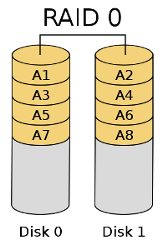
RAID 1
In this case we are dealing with considerable redundancy - each disk array has its mirror image - an exact copy of that in the event of damage to the root disk takes over his role. The greatest reliability can be achieved when using "mirroring'u" with "duplexingiem" in which we use controller mirrored disks. The level of safety
The high level of fault tolerance requires 100% redundancy - by which the efficient use of disk space is 50%. The unquestionable advantage is the relatively quick recovery and the fact that even the simplest controllers support the so-called. "Hot-sparing." This configuration is used in applications requiring a high level of fault tolerance at the lowest cost - a small database systems, servers, industrial.
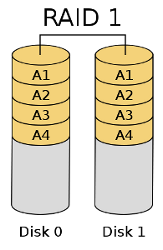
RAID 2
RAID level 2 is fairly non-standard solution-oriented high level of fault tolerance. Stripping in this case takes place at the byte level and the applied redundancy is related to the correction of Hamming codes. Redundant data are determined at each write operation and read to validate stored data accurately. Level 2 requires multiple disks to store redundant data thus decreasing efficiency in the use of disk space. For example - 10 disks with data redundancy requires 4 disks (71% efficiency), 32 hard drives dodatokwych need seven (82% efficiency). This configuration allows for correction of errors on the fly, but it is only possible if a single disk failure. This level is not currently used.
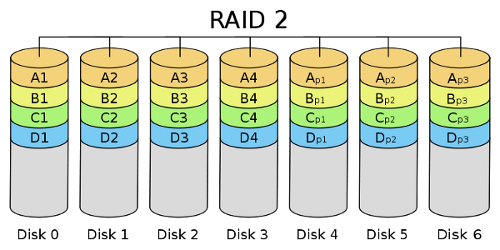
RAID 3
In RAID level 3, just to level 2, also we are dealing with "strippingiem" at the byte level, but the redundancy is reduced to generate the appropriate sequence of parity bits. In connection with the use of a single disk redundancy gain greater efficiency in the use of disk space. But the fact that all the redundant information is stored on the same drive adversely affect the performance of disk operations due to the need of continuous references to the drive. The matrix for this configuration is able to survive one disk failure, but the potential recovery can be relatively time consuming and take several hours.
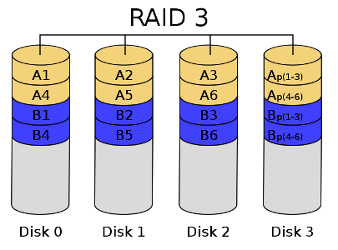
RAID 4
Level 4 is very similar to the 3rd level (redundant data is stored on a separate, single disk drive) with the difference that in this case, stripping occurs at the byte level. The division into larger fragments resulted in improved performance read and write operations, however, performance was further reduced by storing data on a single disk. This type of configuration is not often used - is a compromise between RAID 3 and 5, and as such has no definite area of application.
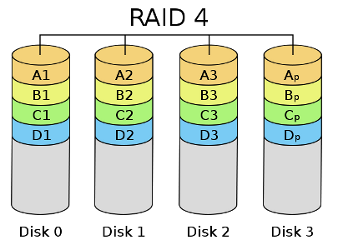
RAID 5
RAID 5 addresses the problem of redundant data storage on the same drive and the resulting reduction in capacity. In this configuration, the parity is stored in the correct order on all drives of the matrix. There are many algorithms for block-level storage write parity - picture shows just one of them. Due to the use of distributed redundancy matrix is able to work in a degraded, even during its reconstruction.
RAID 5 is seen as the ideal combination of performance, efficiency and capacity to tolerate damage. It is used in general purpose environments as well as more explicit as relational databases.
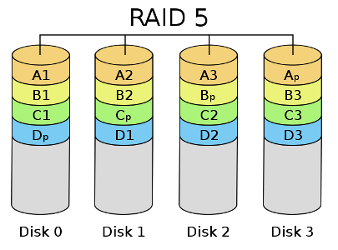
RAID 6
Level 6 is an improvement-oriented Level 5 to improve the damage tolerance. In this case, for each group of data blocks are calculated two redundant information, so that this matrix is able to survive failure of any two drives. This is done at the expense of performance - overhead associated with redundant data generation. Dual redundancy allows you to delay the time to rebuild at the moment not to lose the maximum efficiency of disk operations.
RAID 6 is suitable for use in environments similar to RAID 5 but need additional mechanisms to tolerate faults. But it is not widely used - often used in RAID 5
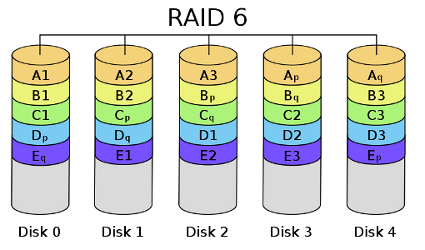
RAID 7
Level 7 is not an IT standard – it's a business card Storage Computer Systems. This configuration combines the concepts of level 3 and 4 and relies on a fancy controller with a cache of high capacity.
Combining different levels of RAID
The more sophisticated controllers allow you to connect together the various levels in order to obtain additional benefits. In general, this combination is an appropriate distribution disk into groups within which we use a specific RAID level and then apply a different level for the whole group. The following example will help to illustrate this approach.
If you live near Indianapolis please visit site: RAID data recovery service in this town.
RAID 1+0 and 0+1
Both RAID solutions are similar, but not identically constructed. In an exemplary implementation, we have four disks, which are divided into 2 groups of 2 drives. For RAID 0+1 within the group use level 0, and the groups use the level 1 (mirrored - one group is a copy of the other). For RAID 1+0 within the group use level 1, and the groups use the level 0 As you might expect both solutions combine the advantages of the two levels - one level of fault tolerance and performance of disk operations offered by the level 0 Used in applications requiring both performance and fault tolerance.
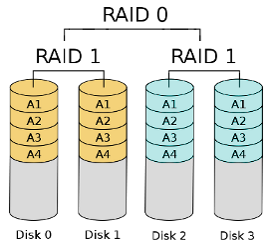
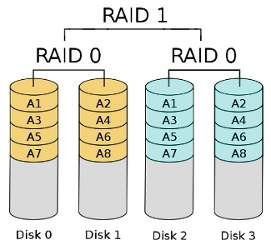
RAID 5+0
Two groups of hard disks, each of which is configured as a RAID 5 configuration have been combined in RAID 0. In this way we obtain a significant improvement in reading and writing, but it does the high cost of the controller and drives. It is used in environments requiring a high level of fault tolerance, high capacity and speed readings. Used in large database systems.
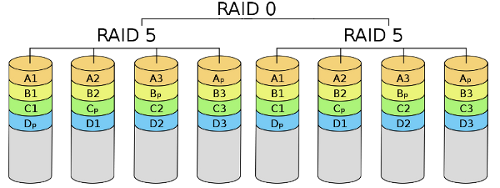
Summary
Building a RAID is quite an expensive investment - especially if you decide to configure RAID 5, which will require special controller, not to mention the need to purchase at least 3 disks. In applications everyday people who need above-average performance I would recommend 2 drives in RAID 0 for operating system software and the current files and a large single disk for storing data. If someone really care about data security should think about using RAID level 1.
If you lost your data please use salvage data recovery service - hard drive and raid data recovery
For this post we used Wikipedia images.

